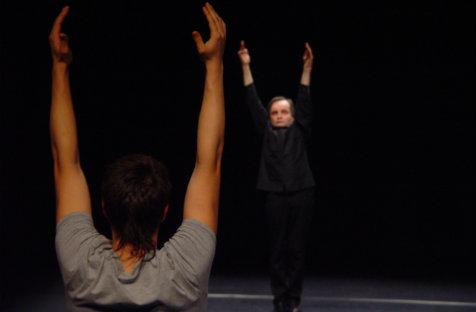There have been many versions of Stravinsky and Nijinsky’s groundbreaking Le Sacre du Printemps (The Rite of Spring) since its tumultuous premiere one hundred years ago – Macmillan, Bausch, Massine, Prelcolaj and Tankard’s versions spring to mind instantly, to name just a few. Given this is the production’s centenary year, it is great to see another version of this towering work – one that is striking and original – presented as part of the Sydney Festival.
Created in 2004, this is the Australian premiere of German writer turned choreographer Raimund Hoghe’s Sacre – The Rite of Spring. Extremely intense, sparse and minimalistic, it opens with a 1963 voiceover of Stravinsky recalling the riotous opening night of Le Sacre du Printemps in 1913, and closes with another voiceover, describing his return to the rooms where he wrote the famous score.
Hoghe, a portrait artist, performer, dramaturg and writer, worked for years with the legendary Pina Bausch. He has created several original group works across his career as well as re-workings of seminal dance works such as Bolero and Swan Lake. Hoghe is of slight build, middle aged and a hunchback. In his version of Sacre, his distinct physicality is contrasted with the tall, young and athletic Lorenzo De Brabandere .The completely different ways their bodies move adds yet another aspect to this work.
Hoghe is clad in formal theatrical black, de Brabandere in casual t-shirt and track pants. The same goes for the pianists – are the meant to be alter-egos for the dancers or vice-versa? Much attention is paid to the mathematics, counts and rhythms behind the score, which drives Hoghe’s choreography. Sometimes the dancers go ‘against’, it but mostly they are immersed inside it.
The live soundtrack for the work is the two piano score version; Guy Vandromme and Alain Franco play Stravinsky’s liquid yet spiky, relentless, fiendishly complicated and driving score superbly, from two pianos placed at the rear of the stage, which is otherwise bare save for a small plastic container of water and a small potted shrub.
Choreographically, Sacre opens quietly, the two dancers lying in an ‘l’ shape and subtly raising their legs. As the work progresses, Hoghe’s choreography is sometimes circular. A limping shuffle is contrasted with powerful, explosive runs and jumps. Intimate frozen leaning sculptural tableaux are also featured. There is also a strange ritualistic, repetitive feel to the work, including prostration and prayer. In various sections the performers intently observe and mirror and/or echo each other.
The piece also features the use of water (the water of life?) used almost baptismally; at another point there is an intimate – but here not really emotionally moving – manipulation of a ‘dead’ body. Some of the choreography is possibly reminiscent of Rafael Bonachela’s early work for Rambert.
At one point it is as if the artists are like heavy trees in spring; another section features a difficult, upside-down lift. There are also yoga influences. Are we meant to read anything into the symbolism of the clock/metronome-like movement (time?) and the square of red cloth? (An allusion to the red dress in Bausch’s version?)
Despite all this, there is no sense of interaction with the audience; all is coolly neutral and impassive. Often, the dance and the music had the feeling of being two separate parts rather than joining together, and the choreography, with its basic, simplistic, repetitive mirroring didn’t really go anywhere or inspire. For a work such as Sacre the production needs to be gripping, compelling and huge, and this wasn’t. The various elements, while interesting in and of themselves, didn’t gel – the result, overall, was rather alienating.
As one of the major opening works of this year’s Sydney Festival, Sacre – The Rite of Spring was somewhat of a disappointment. Some academic dance theorists might love it, but there were walkouts, with some audience members ranting in disbelief in the foyer at the show’s conclusion. While I was disappointed, I would be very interested to see some of Hoghe’s later works.
Rating: 3 stars out of 5
Sacre – The Rite of Spring
Concept: Raimund Hoghe
Choreography and dance: Raimund Hoghe, Lorenzo De Brabandere
Artistic collaboration: Luca Giacomo Schulte
Piano: Guy Vandromme, Alain Franco
Stage and light: Raimund Hoghe
Technical director: Johannes Sundrup
Carriageworks, Eveleigh
5 – 8 January
Sydney Festival 2013
5 – 27 January





